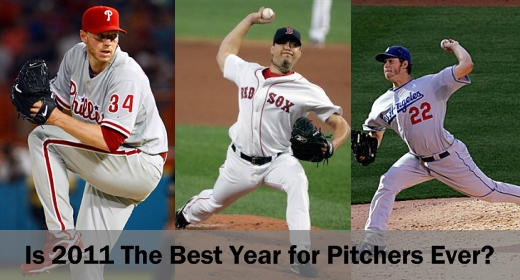Smaller ballparks, bigger hitters, juiced baseballs – no worries for MLB pitchers this year. So far in 2011, more starting pitchers than ever have sub 3.0 ERA’s than in the last 10 seasons. Is this the start of something magical or will it turn out to be an anomaly?
Pitchers with ERA’s Under 3.0
Using a 3.0 ERA as our cutoff point, we found that more pitchers than ever have ERA’s under 3.0. Sure, it’s early in the year, but these numbers tell us that quality pitching is on the rise. Let’s take a look at how these numbers stack up historically:
Sub 3.0 ERA’s by Year
- 2000 – 4 Starting Pitchers met Criteria
- 2001 – 2 Starting Pitchers met Criteria
- 2002 – 9 Starting Pitchers met Criteria
- 2003 – 8 Starting Pitchers met Criteria
- 2004 – 7 Starting Pitchers met Criteria
- 2005 – 9 Starting Pitchers met Criteria
- 2006 – 2 Starting Pitchers met Criteria
- 2007 – 1 Starting Pitcher met Criteria
- 2008 – 8 Starting Pitchers met Criteria
- 2009 – 10 Starting Pitchers met Criteria
- 2010 – 15 Starting Pitchers met Criteria
- 2011 – 19 Starting Pitchers met Criteria
We can see from this data that sub 3.0 ERA’s are a growing trend, especially in the last 4 seasons. Ok, so what’s the reason for this shift towards pitching?
[ad name=”GAS-Blog-Banner”]
Technology Benefits Pitchers More
These days, there are cameras everywhere which means that there is enough data on hitters to fill the congressional library. Pitchers already have an advantage over the hitters no matter how much scouting the hitter has, so this growth in data really benefits the pitchers even further. A batter who is familiar with a pitcher might know that he likes to go to his cutter when he is down in the count. This gives him somewhat of an edge because he can sit on one pitch and drive it. In order for a pitcher to flip that advantage in his direction, he just has to not throw his cutter at certain points in the count. On the other side of things, a pitcher who has done his homework might know that no matter what, a particular batter cannot hit changeups low and away. It is a lot harder for a batter to make an adjustment in his advantage than a pitcher in similar situations. In other words, scouting reports go a lot further in a pitcher’s hands than a batter.
No More Steroids?
Without naming any names, the numbers seem to indicate that a greater number of hitters were on steroids than pitchers. When the league really began cracking down on steroids, it wasn’t much of a surprise that offensive numbers began to drop off and pitchers once again regained the advantage. Now I’m not claiming that steroid use has been completely obliterated, or even that all hitters back in the early 2000’s were juiced up, but I am saying that it is a pretty strange coincidence that Major League Baseball makes extended efforts to reduce its usage and offensive numbers fall. Just Saying.
[ad name=”GAS-Blog-Banner”]
Small Ballparks Changed the Game
I know what you’re thinking – don’t small ball parks favor offensive players? Yes, they actually do but the influx of small parks, created a monster that teams decided that they needed to battle. Follow me for a minute here please. In a big ballpark, only the true power hitters could reach the seats, meaning small ball was prevalent. As the fences moved in, the number of players who could conceivably hit homeruns on a regular basis improved. These players weren’t pure power hitters like we had seen in years past, but rather guys with average power in the right park at the right time. With GM’s realizing that just about any old Joe could hit for power in these new parks, they didn’t have to spend so much on creating a monster lineup and instead decided that a strong pitching staff was the way to go. Home run numbers might be up, but overall, we were left with an increased emphasis on quality pitching. Think about it.
Whatever the reason, as someone who loves small ball, it is nice to see pitching become more dominant again. The young pitching taking over in Atlanta reminds me of the days of Glavine, Maddux, and Smoltz – and that’s a good thing. The Phillies rotation is about as dominant as we all feared, and even in towns where baseball might not be the evening’s hot ticket, young pitchers are stepping up and showing us some magical stuff.
